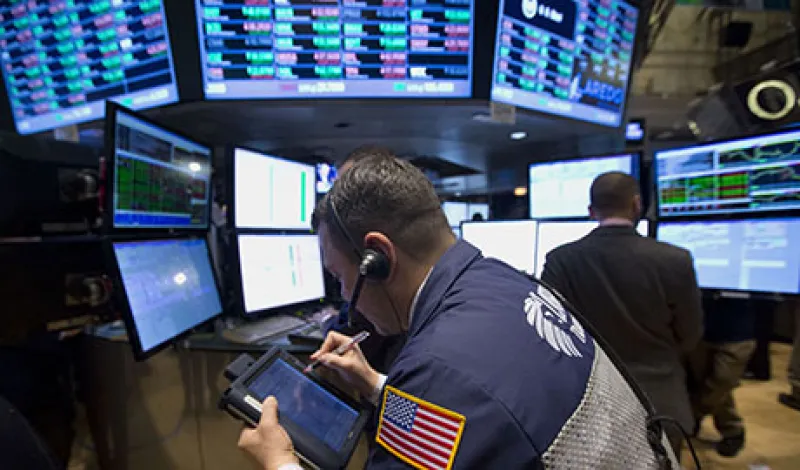Flash Boys, the latest book by financial journalist and Vanity Fair contributing editor Michael Lewis, describes a world of high-tech electronic trading in which running cables between exchanges can make a millisecond’s difference between profit and loss and in which arbitraging the slow-moving dinosaurs to make riskless profits is the name of the game. Lewis’s March 30 appearance on the Sunday evening news program 60 Minutes, with the indictment that markets, as Lewis put it, are “rigged,” has sparked spirited debate across the U.S. over high frequency trading (HFT) — the practice of buying and selling securities at extremely fast speeds.
Equities trading has become so replete with information that knowing how to code and how to game the algorithm is as important as understanding the ebbs and flows of the markets themselves. The modern demands of trading require a speed of execution that humans can’t replicate.
“Clients want efficiency,” says Brian Pomraning, head of electronic client solutions–Europe/Middle East/Africa and liquid markets products at J.P. Morgan in New York. “They have the need to execute hundreds of orders. Our algos can process orders and react to any variables at any time across a wide range of securities and sectors. They allow functions that a single human brain cannot perform.”
The broker focus on HFT isn’t surprising. Equity trading volumes have been lurching downward since the financial crisis and hit 15-year lows last year. There were 30 percent fewer trades in August 2013 than in August 2007. In 2012 revenues from equities were at 55 percent of 2007 levels, according to research from New York–based global management firm Oliver Wyman. HFT firms offer liquidity, and electronic trading reduces costs.
Wall Street has culled many of the high-profile desk traders during the past few years as a cost-cutting measure after the 2008–’09 financial crisis. In addition to fewer human traders, the advent of HFT pushed the envelope on execution. In the battle to compete with HFT firms, banks embarked on an arms race to improve their technology, reduce latency (the time it takes for a trade to be executed from the moment it is placed) and develop superior quantitative algorithms to search for liquidity in the darkest recesses of the market.
A shrinking buy-side commission pool, driven by regulatory changes such as the U.S. Securities and Exchange Commission’s Regulation National Market System (Reg NMS) and the European Union’s Markets in Financial Instruments Directive (MiFID), both of which push for fairness in fulfilling market orders, has forced a change of behavior from banks, which have moved toward client profiling.
Dwindling volumes and fewer banks making markets have shriveled the equity liquidity base, which is where algorithms help, because they allow investors to find the other side of the trade. Algorithms also provide for cost-effectiveness. Electronic trades cost nearly half the amount charged by traditional brokerages.
Institutional investors mourn the loss of relationships with the sell-side equity brokers. “We see more and more young graduate types on sales desks,” says one trading head at a buy-side firm. “They are more groomed to understand the electronic stuff, and maybe if they have enough personality they can speak to clients too and cultivate relationships,” he says. “But you have lost the history of the relationship.”
Do human traders still have a hope for connections, or has the industry moved into a “It’s not you; it’s me” situation? Traditional sales traders can indeed survive the technological revolution but will need to build out their electronic trading skill set and combine it with their extroverted personalities.
“You now need sales traders to be experts across a much wider range of capabilities,” says Paul Squires, head of trading at AXA Investment Managers in London. “You have the two extremes: the IT engineer, who can tell you all about the algorithm, and the traditional sales trader, who has lots of banter but little idea about algorithms. The optimal for us now is someone who can do both.”
And in fact the number of sales traders has rebounded somewhat after the financial crisis. “Back in 2000, when algo trading started, many commentators were quick to predict the death of the sales trader,” says Richard Balarkas, managing director at Quendon Consulting in London. “That simply hasn’t happened. There may be fewer of them, but many buy-side firms still see the sales trader as pivotal to their broker relationship.”
Balarkas is an electronic trading pioneer. During the late 1990s he set up Credit Suisse’s electronic and algorithmic equity trading platforms. He says that machines aren’t all-encompassing, at least not yet. Computers can’t handle less-liquid assets, nor are algorithms useful for dealing with big block trades. Certainly they don’t provide investors with nuanced opinions on the market. And many buy-side firms are suspicious about dealing with high frequency traders.
“These guys seem to make money every day,” says Jeffrey Knight, head of global asset allocation at Columbia Management Investment Advisers in Boston. “The recipe is to extract profits from every trade. It does seem that there can be the amplification of trends, like the flash crash [of May 6, 2010], because of HFT.”
Many banks have already been merging their sales trading desks with their pure trading operations to create execution advisory desks. The sales traders in turn are becoming a new hybrid of market specialists.
And Lewis’s tempest in a teacup might already have blown over. Figures from New York–based Tabb Group show that U.S. HFT profits have declined steadily, from $7.2 billion in 2009 to $1.1 billion last year. (Projections for 2014 from Tabb do show revenues ticking up slightly this year, however, on the back of increased volatility and volume, to $1.3 billion.) Similarly, the HFT share of equity trades has dropped, from 61 percent in 2009 to 49 percent in 2013 in the U.S. and from 38 to 25 percent in the EU.
The broader issue of electronic trading, however, isn’t going away. According to Tabb, 96 percent of institutional investors want to increase the algorithmic flow, whereas the remaining 4 percent want to increase their sales trading capabilities. Although this doesn’t necessarily herald a revival in the sales trader, maybe the machines haven’t won — yet.






